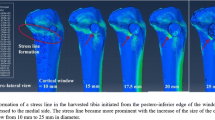Abstract
A novel canine tibia model was used to evaluate four bone graft materials: autologous cortical bone, allograft cortical bone, hydroxyapatite/tricalcium phosphate (HA/TCP) ceramic granules, and a HA/TCP and collagen composite. Mechanical material properties were assessed using custom-designed stainless steel plugs for control of graft volume and interface surface area. These plugs held the bone graft materials in the cortex of the tibia shaft and allowed in vivo mechanical testing. After 6 months of ad lib weight bearing, the grafts were harvested and tested in torsion. The samples in each animal were compared with the test plugs into which new bone had grown without the addition of graft. Control bone peak shear strength averaged 47 (±8.3) MPa (6.78±1.2 kpsi). Compared on the basis of peak torque, stiffness, and energy to peak torque, no significant differences were found among any of the graft materials or control bone. Histologic examination revealed the materials to be osteoconductive with the extensive formation of dense, compact cancellous bone. The new bone in the autograft and allograft samples completely filled the available space, whereas gaps persisted in the synthetic ceramics.
Similar content being viewed by others
References
Prolo DJ, Rodrigo JJ (1985) Contemporary bone graft physiology and surgery. Clin Orthop 200:322–342
Burstein AH, Frankel VH (1971) A standard test for laboratory animal bone. J Biomech 4:155–158
Russotti GM, Okada Y, Fitzgerald Jr RH, Chao EY, Gorski JP (1987) The efficacy of using calcium phosphate particles to enhance the biological fixation of a femoral component. In: Brand RA (ed) The hip. CV Mosby, St Louis, pp 120–154
Hubbard WG (1974) Physiological calcium phosphates as orthopaedic biomaterials. PhD Dissertation, Marquette University
Toth JM, Hirthe WM, Hubbard WG, Brantley WA, Lynch KL (1991) Determination of the ratio of HA/TCP mixture by x-ray diffraction. J Appl Biomater 2:37–40
McPherson JM, Piez KA (1988) Collagen in dermal wound repair. In: Clark RAF, Henson PM (eds) The molecular and cellular biology of wound repair. Plenum, New York, pp 471–496
Toth JB, Lynch KL, Hamson KR (1992) Osteoinductivity by calcium phosphate ceramics. 4th World Biomaterials Congress, Berlin, Federal Republic of Germany, April 24–28
Yamada H (1970) Strength of biological materials. Williams and Wilkins, Baltimore, p 43
Bucholz RW, Carlton A, Holmes RE (1987) Hydroxyapatite and tricalcium phosphate bone graft substitutes. In: Friedlaender GE (ed) Bone grafting. WB Saunders, Philadelphia, pp 323–334
Cornell C, Lane J, Henry S (1991) Multicenter trial of Collagraft as a bone graft substitute. J Orthop Trauma 5:1–8
Daculsi G, Passuti N, Martin S, Deudon C, Legeros RZ, Raher S (1990) Macroporous calcium phosphate ceramic for long bone surgery in humans and dogs. Clinical and histological study. J Biomed Mater Res 24:379–396
Damien CJ, Parsons JR (1991) Bone graft substitutes: a review of current technology and applications. J Appl Biomater 2:187–208
Ducheyne P (1987) Bioceramics: material characteristics versus in vivo behavior. J Biomed Mater Res: Applied Biomaterials 21:A2,219–236
Flately TJ, Lynch KL, Benson M (1983) Tissue response to implants of calcium phosphate ceramic in the rabbit spine. Clin Orthop 179:246–252
Geesink RGT, De Groot K, Klein CPAT (1987) Chemical implant fixation using hydroxylapatite coatings. The development of a human total hip prosthesis for chemical fixation to bone using hydroxyl-apatite coatings on titanium substrates. Clin Orthop 225:147–170
Gross TP, Jinnah RH, Clarke HJ, Cox QGN (1991) The biology of bone grafting. Orthopedics 14(5):563–568
Jarcho M (1981) Calcium phosphate ceramics as hard tissue prosthetics. Clin Orthop 157:259–278
Lane JM, Sandhu HS (1987) Current approaches to experimental bone grafting. In: Friedlaender GE (ed) Bone grafting. Orthopedic Clinics of North America 18:2, WB Saunders, Philadelphia, pp 213–235
Legeros RZ (1980) Calcium phosphate materials in restorative dentistry: a review. Adv Dent Res 2(1):164–180
Luyten FP, Cunningham NS, Ma S, Muthukumaran N, Hammonds RG, Nevins WB, Wood WI, Reddi AH (1990) Bone fide osteoinductive factors. J NIH Res 2:67–70
Lynch KL, Toth JM, Hamson KR, Ho KC, Hirthe W (1990) Osteoinductivity by subcutaneous implantation of a collagen/ceramic composite. In: Bioceramics, vol. 3. Rose Hulman Institute of Technology, Terre Haute, IN, pp 295–304
McIntyre JP, Shackelford JF, Chapman MW, Pool RR (1991) Characterization of a bioceramic composite for repair of large bone defects. Ceramic Bull 70:9,1499–1503
Ohgushi H, Okumura M, Tamai S, Shors EC, Caplan AI (1990) Marrow cell induced osteogenesis in porous hydroxyapatite and tricalcium phosphate: a comparative histomorphometric study of ectopic bone formation. J Biomed Mater Res 24:1563–1570
Author information
Authors and Affiliations
Rights and permissions
About this article
Cite this article
Hamson, K.R., Toth, J.M., Stiehl, J.B. et al. Preliminary experience with a novel model assessing In vivo mechanical strength of bone grafts and substitute materials. Calcif Tissue Int 57, 64–68 (1995). https://doi.org/10.1007/BF00298999
Received:
Accepted:
Issue Date:
DOI: https://doi.org/10.1007/BF00298999




